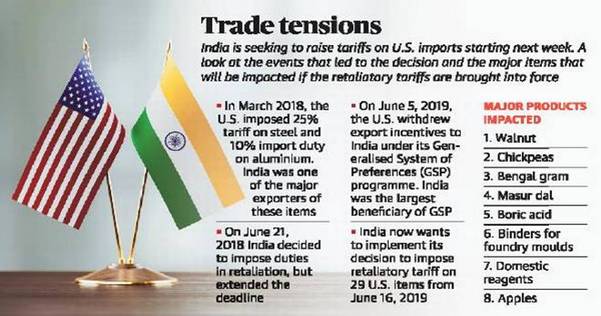



India to impose retaliatory tariffs on 29 American goods
India to impose retaliatory tariffs on 29 American goods
Topic Important for: General Studies- 3 I International relations- Bilateral, regional and global groupings.
Context:
The government of India has imposed retaliatory tariffs on the imports goods from U.S.
Background:
About:
|
The Generalized System of Preferences The Generalized System of Preferences (GSP) is a U.S. trade program designed to promote economic growth in the developing world by providing preferential duty-free entry for up to 4,800 products from 129 designated beneficiary countries and territories. |
The objective of GSP:
What is the impact of GSP withdrawal on India?

Benefits of Generalized System of Preference
Indian - U.S. Exports
Head of 32,000-year-old wolf found in the Russian Arctic
Topic Important for: General Studies- 3 I Bio diversity, Environment.
About:

WPI inflation at 2-year low in May
Context:
The wholesale price inflation is reported at was at 6.99%, down from 7.37%.
About:
Wholesale price-based inflation hit a low of 2.45% in May on falling prices of food articles, fuel and power items.
The Wholesale Price Index (WPI)-based inflation:
What is Wholesale Price Index (WPI)?
The main uses of WPI are the following:
What are the reasons:
This is clearly an indication of weakening of demand impulse in the economy.
The delayed and less than normal monsoon could aggravate the food inflation further in the coming months.
The government monitors the situation proactively, checks speculative activities, and intervenes in the market to stabilise prices.
The death of children was reported due to suspected Acute Encephalitis Syndrome (AES) in Bihar.
Topic Important for: General Studies- 2 I Issues relating to Health
About:
Acute Encephalitis Syndrome (AES)
Causes:

© 2025 iasgyan. All right reserved